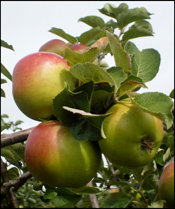Story by Christine Slomski
Your feet sink into the thick, dewy grass, and the odors of country flowers and cows out to pasture tickle your nostrils. No traffic, no city lights, just country air and open sky. It’s you and Mother Nature in the apple orchards of Armagh County.  As far as you can see, rows of apple trees stand poised on the sloping hills of the orchard town Loughgall, just five miles outside Armagh’s city center. Dating back over a thousand years, the orchards are as old as the city itself and produce a cornucopia of varieties, including the famous Bramley cooking apple. Even St. Patrick, who brought Christianity to Ireland, may have had a hand in seeding these orchards that thrive today in Armagh. And with apple festivals, tours through the orchards, and a National Apple Day, there’s no doubt which fresh produce puts Armagh on the map.
Historians believe that the apples of Armagh have been present in Britain and Ireland since Roman rule. Legend has it that even as St. Patrick brought Christianity to Ireland, he also brought the apple tree with him, planting it in Ulster County at the ancient settlement of Ceanoga. However, there are a few accounts of the Culdees (Druids) in Northern Ireland who reportedly ate apples at meals and worshipped the trees as part of their spiritual communion with nature. The presence of the druids in Ireland far precedes any Christian tradition by over a thousand years, which indicates that St. Patrick’s green thumb with apples is likely a myth.
 Widows Whelps, Strawberry Cheeks, and Angel Bites are just a handful of the varieties of apples that come from the orchards, but it is the Bramley that calls Armagh its home. Accounting for roughly 90 percent of the apples grown and processed here, the Bramley was originally grown from seeds by a young girl, Mary Ann Brailsford, who planted the first Bramleys in Nottinghamshire, England, in 1809. The apple gets its name from Matthew Bramley, a butcher who bought the estate in which the original Bramley tree grew.
The Bramley apple is best known for its superb and flexible cooking qualities in desserts, soups, main courses, and sauces. Fresh from the tree itself, the Bramley cannot be eaten because it is very bitter, but when cooked it is mildly sweet, its tangy flavoring making it suitable to serve with virtually anything.
The apple is a lively green and grows as big as a softball. Hundreds of recipes featuring this special apple can be found anywhere in local cookbooks and online. Polls in the United Kingdom “scientifically” prove the superiority of this cooking apple to any other.
Bramley apples can be bought fresh in local supermarkets in Armagh, and once they are picked they are stored in cooling facilities, making them available all year round. The most Bramley apples are pressed into cider, a process which was first documented in Armagh in 1156 A.D. These days locals are proud of their cider, a tradition enjoyed at home and in pubs. Remaining apples are processed, or “sliced and diced,” and put into large cans for catering and bakeries. The orchards receive the most public attention in May when they cover about 6,000 acres of countryside with pink blossoms. This is a busy time of year for Armagh local Barbara Ferguson. Ferguson owns and runs her own tour business, the only tour business for the apple orchards, and has given coach tours since 1999. “It’s my favorite time of year for the apples,” Ferguson says. Ferguson drives the tour routes from Portadown, visiting local villages of Loughgall and Richhill. A typical tour usually takes less than two hours, which includes driving time and a stop for tea and a homemade apple tart.
Dessie Mackle is an orchard owner and apple farmer who takes pride in his extensive orchards of Bramley apples, about 60 acres. A visit to Mackle’s orchards includes a tour of a beautiful two-story home with traditional box-windows and a swing set for his children. Beyond the house are old tractors, trailers, and a cooling facility which houses thousands of crated Bramleys. Living in County Armagh his entire life, Mackle is carrying on the family tradition of apple farming and lives just miles from where he grew up on his father’s apple farm. It truly is a family affair as Mackle grows the apples and sends them to be processed at his brother’s facility just down the road.
“It’s a year-round job,” he says of farming apples. September is the time to harvest the apples, beginning a two-month process. In December, farmers begin to prune and maintain the trees. This continues through April. The apples blossom in May, and then the process begins all over again. In order to harvest his apples, Mackle hires eastern Europeans, mostly students from Poland looking for work. “I never have to look to hire, they always come to me. Every other phone call these days is someone looking for work.”
Stepping into the apple orchards is like stepping back in time; the old-world tradition of caring for nature is seen and felt all around. As a fruit farmer, Mackle knows when he encounters another in his field because there’s a niceness, a mutual understanding for planting and harvesting the gifts of nature.
Though there’s not much opportunity for great wealth as an apple farmer, Mackle says with a smile, “It’s a lovely way of life.”
Story by Christine Slomski
Photos by Nora Daly
Video by Andrew Harrington
Web Design by Meg Carey
|

